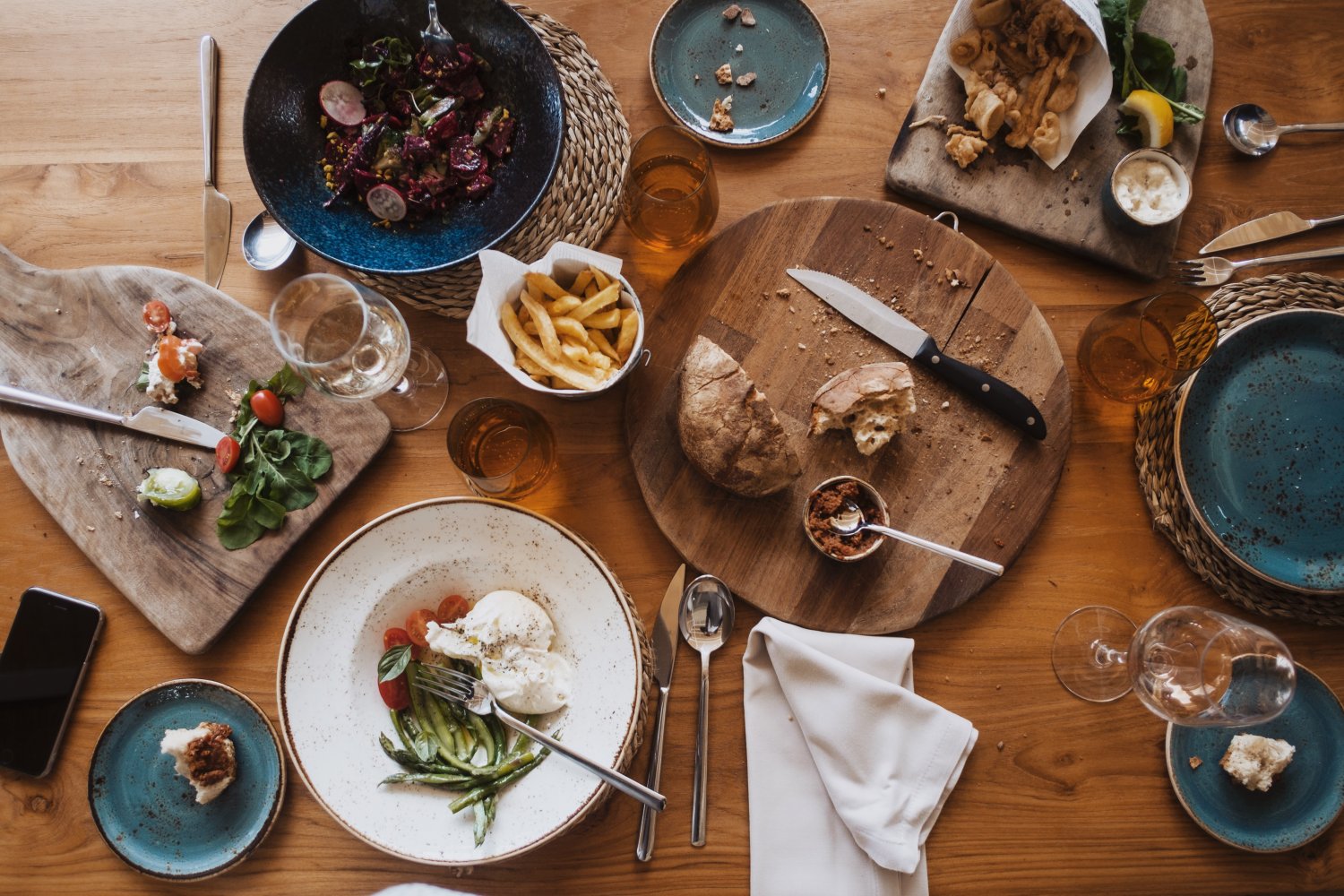Typical Ibizan dishes are generally simple but tasty one-pot specials, which reflect the seasonal availability of local produce and historical influences on the island. Meat (traditionally pork or lamb) and seafood are common, supplemented by rice dishes and fresh salads. Very few ingredients are ever wasted and most leftovers go back into a stock to be reused to make a range of soups and rice dishes.
In the pre-tourism past, the islands - as with many parts of Spain - regularly experienced periods of great scarcity and hardship. Four or five days a week, the islanders would have existed on a subsistence diet, largely supplemented with pulses - especially chickpeas, carob and lentils.
Once a week they may have had a rice dish, with fish or meat only on a Sunday. Many of the favourite dishes of today are made for sharing on celebration and fiesta days, reflecting the need to spread the available ingredients as far as possible.
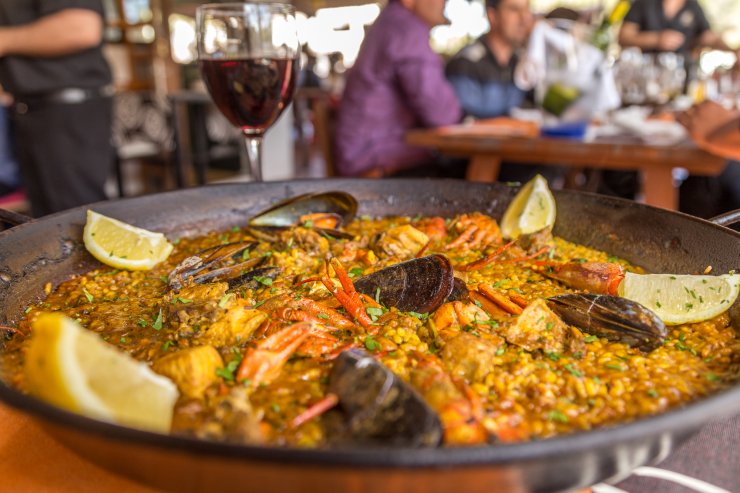
Although on Ibiza, the soil in places can be quite arid, the central areas of the island are very fertile and productive. Many vegetable gardens or huertas produce great potatoes, tomatoes, onions, melons, grapes and, of course, all varieties of citrus fruit, quince, figs, olives and almonds. Ibiza also benefits from an abundance of wild herbs, fennel, mushrooms and asparagus. Many of the country restaurants still insist on growing and utilising as much of their own produce as possible.
Below are our suggestions of foods you should try while visiting Ibiza.
If you would like to see the rest of our article series on Ibizan and Formenteran gastronomy, click on the links below and discover more about the islands' delicious culinary past and present.
PART 1 BREAKFAST AND SNACKS
PART 3 DRINKS
Starters
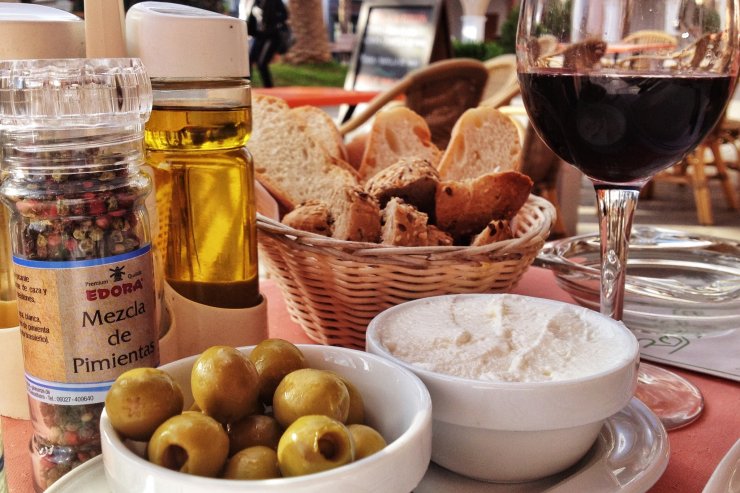
Allioli (simply, "garlic and oil" in Catalan) is an emulsion made from garlic crushed in a mortar and pestle, to which oil and salt are slowly added with a whisk. Textures and flavours can vary by restaurant - from subtle and light, to dense and intense. In Ibiza, allioli is enjoyed spread over pa pagès, a dense, artisanal bread, which initially seems unusual to Northern Europeans accustomed to lighter bakes.
However, its combination with allioli soon becomes extremely moreish and, with a bowl of local olives or aceitunas, it is one of the take home flavours of Ibiza. You will be offered it at almost every Ibiza restaurant but don't be surprised to find it added to your bill at the end of your meal.
 Ensalada payesa
Ensalada payesa
The quality and abundance of fruit and vegetables often amaze visitors to Spain: with onions, tomatoes, peppers and watermelons of huge size. The typical ensalada payesa or "peasant salad" of Ibiza and Formentera contains a combination of red and green peppers, tomatoes, onion, boiled potatoes, boiled eggs, olives, finished with a topping of bread crusts or crostes and dried cod in oil, known as bacalao.
A variation is available in most traditional restaurants but we think you might like to try one prepared at the restaurants Ca Na Pepeta (on the San Juan road) or Cas Payes (on the road to San Carlos).
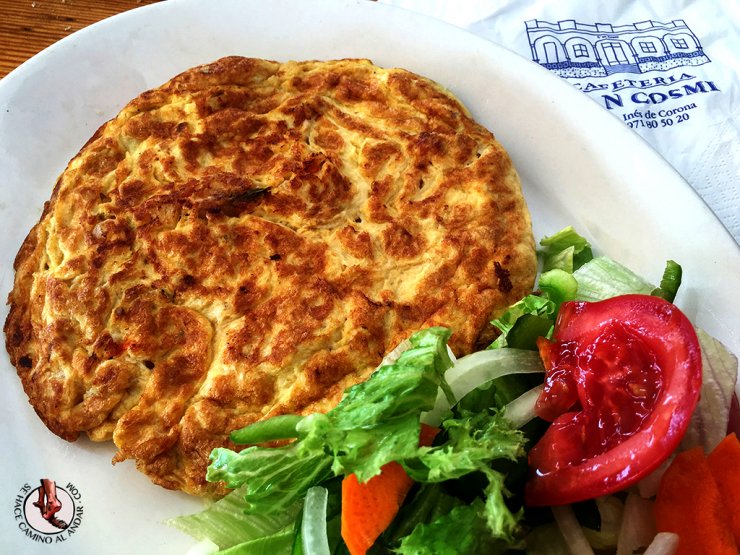
Tortilla de patata (Spanish omelette) – If you are out for a drive in the country and you pass through the beautiful village of Santa Inés you will see the terrace of Can Cosmi restaurant packed with diners sharing a wholesome lunch, while enjoying the tranquil, rural idyll. Made to measure, no matter the size of your group, this simple, traditional omelette made with local potatoes and onions as well as red and green peppers is a much loved dish. Firm on the outside and gooey on the inside, it can be enjoyed all year round.
Breads and cakes
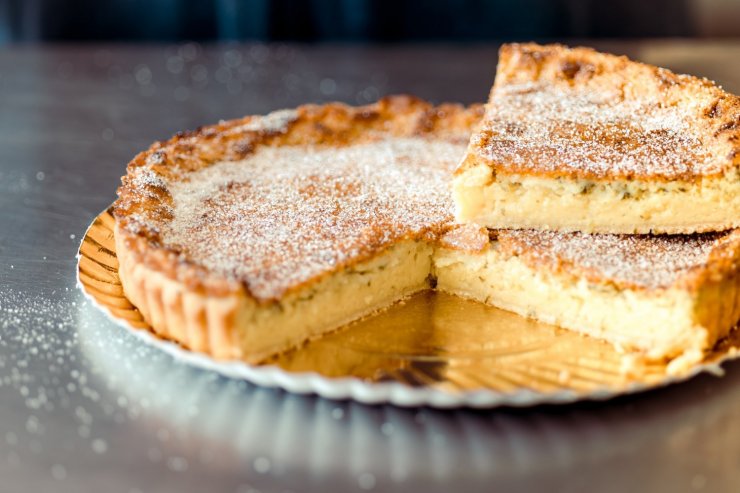
The island has a rich tradition of baking bread and cakes. Whether it's authentic cakes such as flaó, orelletes, and magdalenas, breads such as the local sourdough bread pan payés, or savoury dishes like sofrit pagés, frita de pulpo, arroz de matanza, and bullit de peix, they are part and parcel of discovering Ibiza's culinary heritage.
And there is nowhere better to sample these home-baked and prepared delights than Forn Can Bufí, which prides itself on its close adherence to Ibiza's local produce and recipes. Made with prime local produce such as fresh cheese, mint and lemon, their flaó - the Ibizan cheesecake par excellence - is irresistible. Perfect for takeaway, bespoke cakes for a celebration or its catering service (food only), Forn Can Bufí offers customers the true taste of Ibiza.
Need more proof? Forn Can Bufí has been awarded the prestigious local Ibiza Sabors Prize for its wholehearted commitment to using local produce.
Main courses
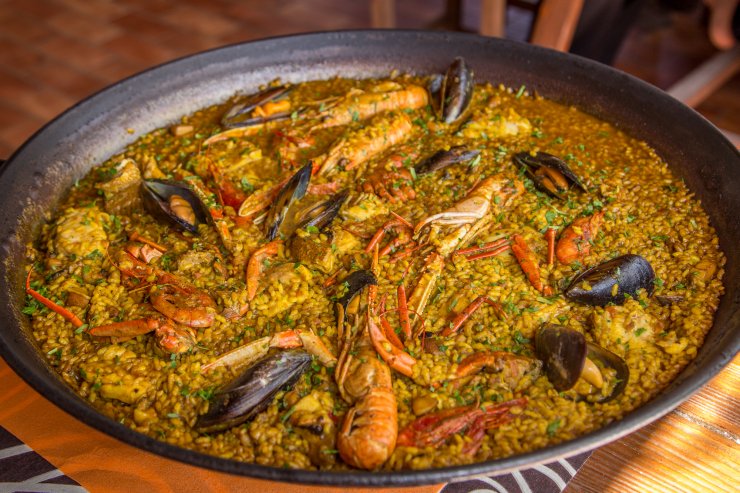
Fish
Paella (pictured above) – No visit to Ibiza would be complete without a long, lazy lunch of Paella de Mariscos, or seafood paella, Ibiza's version of the classic Paella Valenciana. And there is no better way to enjoy it than sharing with friends by the sea. Obviously, recipes and quality can vary, although almost every restaurant will claim they make the best paella in Ibiza!
A good paella should be golden in colour from a subtle addition of saffron, not the lurid yellow indicative of artificial colorants, and with a satisfying crunchy, caramelised bottom. Some of our favourite paellas are served nearly all year at Es Nautic in San Antonio, Sa Caleta Restaurant on the south coast, CBbC Marina in Santa Eulalia, and Hoyo 19 near Cala Llonga. Check out our feature on paellas and rice dishes with many further restaurant recommendations across the island.
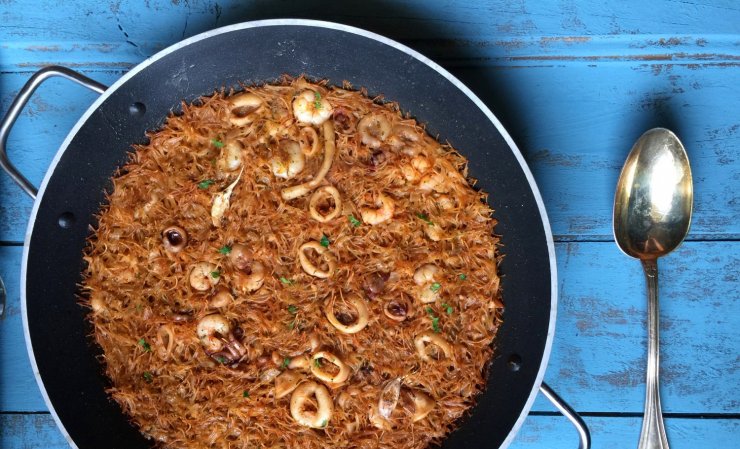
Fideuà – A very popular twist with essentially the same ingredients as paella but made with vermicelli pasta in the place of rice. Many locals swear a preference for this version over the rice dish.
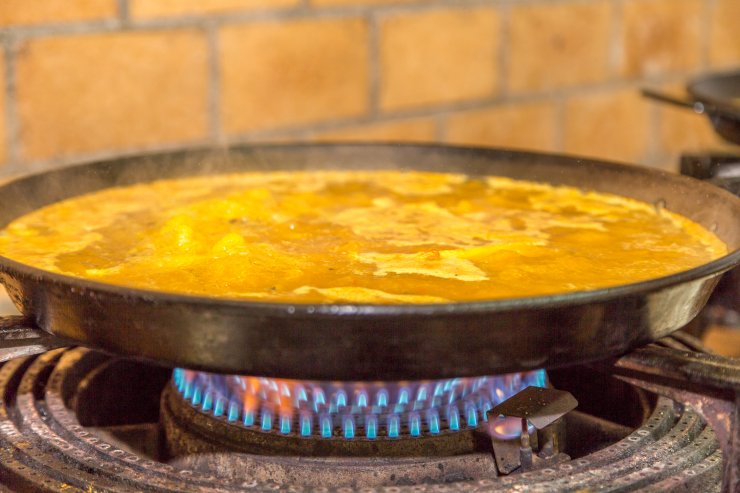
Bullit de Peix - literally translated as "boiled fish", this dish derives from a time when fish was abundant and cheap and the fishermen caught food for themselves and their families. However, the families of the island interior may have only got to see the fishermen once in a while and, when they did, it was cause for celebration. Considered by many to be THE typical dish of Ibiza, this stew of fish and potatoes in a garlic, tomato and saffron sauce is served as a centrepiece at all of the top traditional restaurants.
Historically it was made with small, spiny fish; nowadays, only the finest quality ingredients are used, including monkfish, John Dory and grouper. Some restaurants serve it literally drenched in allioli, which is a shame because it can detract from the quality of the fish. However, the best restaurants leave it up to the diner to decide how much allioli to add.
The stock produced in the making of Bullit de Peix is reserved to make the accompanying dish of Arroz a Banda – a personal favourite of the author, as it is a rice dish without the fuss of paella. There is no need to get your fingers dirty as Arroz a Banda is usually prepared with just slices of squid, although it gets even better with extra peeled prawns and clams added.
It's best eaten by the sea at one of Ibiza's favourite seafood restaurants, where fresh fish is delivered daily, such as Es Pou de Lleo (a hostal), the much acclaimed Es Ventall in San Antonio, Es Bigotes in Cala Mastella, El Gallo Viejo in the bay of San Antonio or Sa Caleta Restaurant. Inland, one of the guardians of traditional Ibizan cuisine, S'Espartar, close to the village of San José, is another great place to enjoy it.
Other local seafood favourites we recommend you should try include:
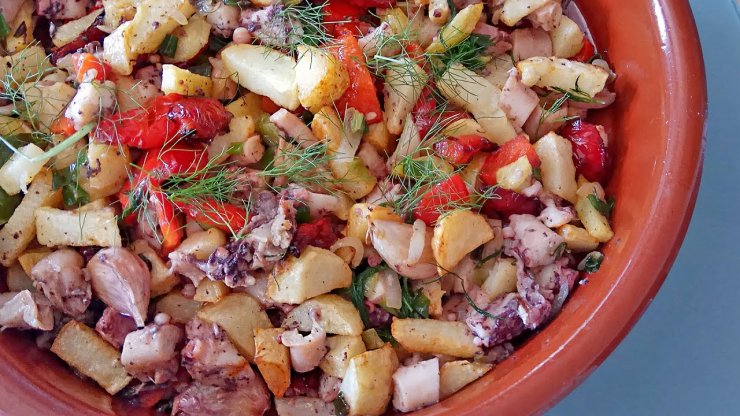
Frito de Pulpo or Frito de Calamares – fried octopus or squid with potatoes
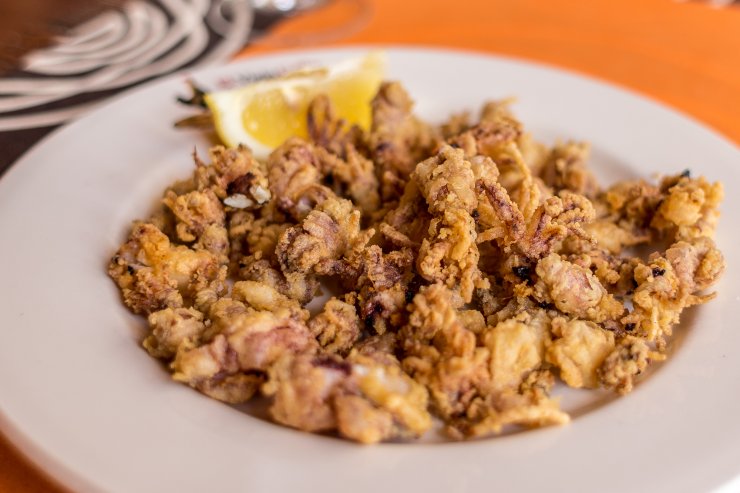
Chipirones – baby squid deep-fried in batter.
Almejas (clams), or young Mejillones (mussels) in wine sauce.
Sardinas (sardines) – Who can resist a plate of fresh, grilled sardines on the beach? Try them at Tothom in the port of San Miguel, at one of the restaurants in Cala Martina, the Aquarium in San Antonio, the Fish Shack at Sa Punta, Talamanca, or Bar Can Sulayetas, outside the village of San Miguel.
Those with a generous budget, should look out for bogavante or langosta (the two local varieties of lobster) or cigalas (langoustines).
Meat
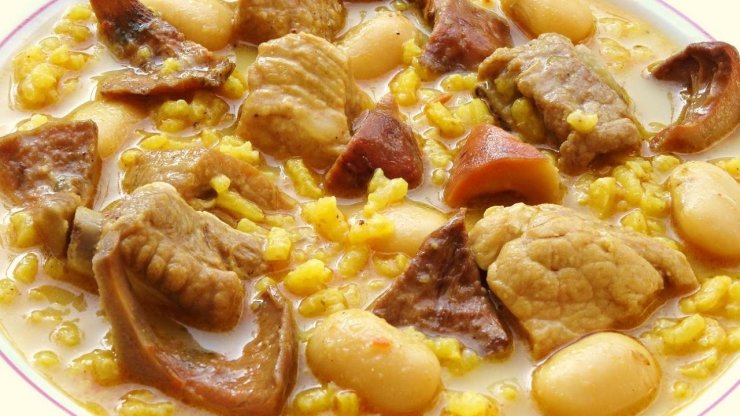
Arroz de matanzas – using up leftovers from the pig slaughter, this is a hearty soup with offcuts of pork in stock, thickened with rice and vegetables. Visit Sa Palmera in Santa Agnès in the autumn, to enjoy this welcome addition to the winter menu.
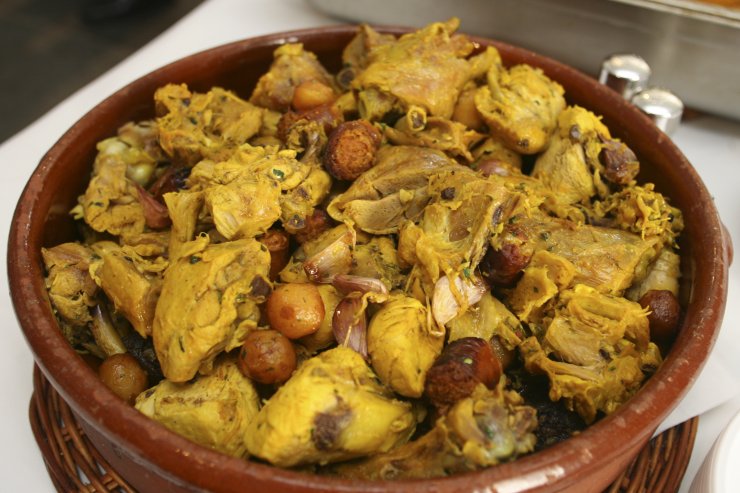
Sofrit Pagès – Cooked for the most special fiestas and celebrations, this dish is a rich stew of mixed meats, principally chicken and lamb, but also goat or rabbit, with local sausages (sobrasada and butifarra), potatoes and vegetables, including artichokes. Sofrit is best eaten in the winter, after the matanzas, when the embutidos are considered to be of best quality. S'Espartar in San Jose makes an excellent Sofrit Pagès, which is highly regarded by locals.
Ibiza has a thriving lamb industry and fans should try some young chuletas de cordero, or lamb chops; they're always bursting with flavour.
Here are a couple of our suggestions where meat lovers can head out to the country and try some local produce. Balafia, on the scenic road to San Juan, serves delicious baby lamb chops, and Can Caus, in Santa Gertrudis, serves its own produce, including baby goat. There are, of course, many more for you to search out and discover.
Desserts
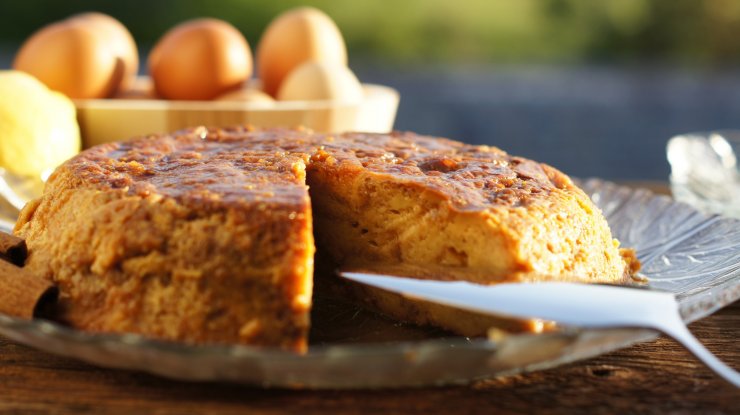
Greixonera is probably best described as a crème-caramelised bread pudding, utilising yesterday's leftover ensaimadas, a local pastry that's usually served at breakfast time. Sometimes this pudding can be a little over egged, but a good one is simply delicious.

Flaó – an Easter favourite dating back as far as the 13th Century, flaó is a dense cheesecake with a filling of sheep or goat cheese, eggs, sugar and then aromatised with hints of mint, anise and Ibizan herbs.
We hope you get to try a few traditional local dishes during your visit to Ibiza. Anyone wishing to find out more about the culinary history of Ibiza and Formentera, or to try some local produce, should contact Ibiza Food Tours and go on one of their gastronomic walking trips through Ibiza Town.
You might be thirsty after all those breakfasts, snacks and main meals, so check out the third and final installment in this series on drinks.
For a great selection of places to eat to suit all tastes and budgets, head to our restaurant guide.
